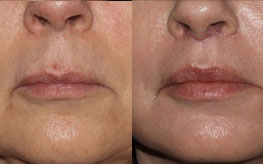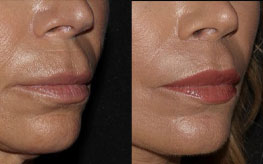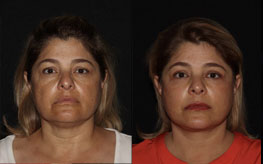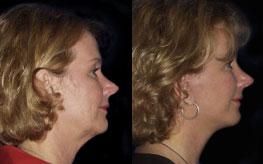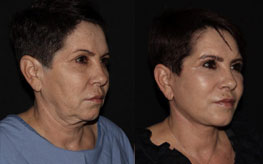Breast Enlargement & Lift
Conveniently located to serve the areas of San Diego, CA

Breast Enlargement -Lift (Augmentation -Mastopexy) is an excellent way to accentuate your curves and restore balance to the body. Often women who have had children find that their breasts are both lower and smaller than before having children. Although a lift can restore fullness to the breast, often there is still a lack of upper breast fullness that requires augmentation with an implant at the same time. A breast enlargement-lift can restore the breast shape. When combined with a tummy tuck, this dual procedure is commonly called a “Mommy Makeover.”
For more information about our breast enlargement and lift procedures, please contact us online or call us at 888-463-9532. We look forward to helping you look your best.
Contents
Before and After Photos
Understanding the Breast Enlargement & Lift Procedure
Over time, a woman’s breasts can begin to lose firmness and fullness due to pregnancy, aging, or both. A breast lift can restore youthful firmness, symmetry, and volume to drooping breasts by removing excess skin and tightening the surrounding tissue to reshape and support the new breast contour.

A breast lift can also be enhanced through the simultaneous placement of breast implants, by performing a Breast Augmentation/Lift, which creates even more fullness of the upper breast. Also known as augmentation mastopexy, a breast enlargement-lift uses breast implants to create fuller breasts (breast enlargement) and a lift to restore the breast to its normal position.
There are four decisions to consider when preparing for this procedure
Incision
Incisions are made to place the implant and to remove excess skin. We will discuss with you which incision options are best for your desired outcome. To see the possible variations in the incisions, see Step 7 in the Procedure Tutorial below.
Type of Implant
There are two types of implants, saline and silicone. The outer covering (shell) of both implants is made of silicone.
Saline breast implants are filled with sterile salt water. The implants come empty and are filled during surgery. They can be filled with varying amounts, which can affect the shape, firmness and feel of the breast. Should the implant shell leak, a saline breast implant will collapse and the saline will be absorbed naturally by the body. Currently Saline breast implants are FDA-approved for augmentation in women 18 years of age and older.
Silicone breast implants are filled with an elastic gel and our pre-filled by the manufacturer. The gel feels and moves much like natural breast tissue. If the implant leaks, the gel may remain within the implant shell, or may leak into the breast implant pocket, but will be contained by the scar tissue capsule, which forms around every implant.
A leaking implant filled with silicone gel does not collapse. If you choose these implants, you may need to visit your plastic surgeon regularly to make sure the implants are intact. An ultrasound or MRI screening can assess the condition of breast implants. Currently Silicone breast implants are FDA-approved for augmentation in women 22 years of age and older. Silicone implants may be recommended at a younger age if used for reconstruction purposes.
Silicone Gummy-bear implants have a cohesive silicone gel inside that is more solid. These implants are currently being studied and will not readily available until approved by the FDA. They are more commonly used in reconstruction cases for breast cancer.
Position of Implant
Implants can be placed above the pectoralis muscle or below the muscle. Most often, implants are placed below the muscle to obtain better soft tissue coverage of the implant in the medial upper chest. Implants below the muscle preserve the most blood supply to the nipple-areola, making the procedure the safest.
Size
We spend a great deal of time discussing size with patients. It is important to make sure that the surgeon and the patient are speaking the same language in regard to size. By looking at photographs in magazines, before and after pictures, and discussing the patient’s desire for their overall look and proportion, we can come to a clear understanding on what each patient desires regarding size. It is more important to focus on the look then it is a specific implant volume.
Before You Decide…
The Consultation
To ensure the most natural looking results, Dr. Alexander and Dr. Kaplan will recommend the procedure that most appropriately matches your needs and to offer realistic expectations for post-surgery outcomes.
Breast size and shape are important, so be honest and open about your expectations when talking with your surgeon. Implant type and size will be determined not just on your desire but as importantly on your breast anatomy, skin elasticity and body type.
The success and safety of your breast procedure depends very much on your being completely candid during your consultation. We will ask you questions about your health, desires and lifestyle.
Be prepared to discuss:
- Why you want breast surgery, your expectations and desired outcome
- Your willingness to accept scars to achieve a better shape
- Medical conditions, drug allergies and medical treatments
- Use of current medications, vitamins, herbal supplements, alcohol, tobacco and drugs
- Previous surgeries
- Family history of breast cancer and results of any mammograms or previous biopsies
We may also:
- Evaluate your general health status and any pre-existing health conditions or risk factors
- Examine your breasts, and may take detailed measurements of their size and shape, skin quality, placement of the nipples
- Take photographs for your medical record
- Discuss your options and recommend a course of treatment
- Discuss likely outcomes of breast augmentation surgery and any risks or potential complications
- Discuss the use of anesthesia during your breast augmentation procedure
Questions to Ask
- Were you trained specifically in the field of plastic surgery?
- Do you have hospital privileges to perform this procedure?
- Is the office-based surgical facility accredited by a nationally or state-recognized accrediting agency?
- How many procedures of this type have you performed?
- Am I a good candidate for this procedure?
- What will be expected of me to get the best results?
- Where and how will you perform my procedure?
- What shape, size, surface texturing, incision site and placement site are recommended for me?
- How long of a recovery period can I expect, and what kind of help will I need during my recovery?
- What are the risks and complications associated with my procedure?
- How are complications handled?
- What are my options if I am dissatisfied with the outcome of my ear surgery?
- Do you have before-and-after photos I can look at for each procedure and what are reasonable results?
Who is a good candidate?
A woman’s breasts often change over time, losing their youthful shape and firmness. These changes and loss of skin elasticity can result from:
- Pregnancy
- Breastfeeding
- Weight fluctuations
- Aging
- Gravity
- Heredity
A breast enlargement-lift is an extremely effective procedure for reversing the effects of pregnancy and aging on the breasts. Patients who have undergone this procedure are generally thrilled with the improvements because they have regained the youthful look and feel of their breasts.
What does it cost?
A quote will be provided to you after your consult. Cost is always a consideration in elective surgery. We offer patient financing plans, so be sure to ask.
Costs include:
- Surgeon’s fee
- Implant cost
- Operating room and supplies
- Prescriptions for medication
- Medical tests
- Anesthesia fees
To learn more about our partner in payment plans, please visit CareCredit.
The Breast Enlargement & Lift Procedure
Prior to surgery, we will have you:
- Take certain medications or adjust your current medications
- Avoid taking aspirin, anti-inflammatory drugs and herbal supplements as they can increase bleeding
- Stop smoking well in advance of surgery
- Depending on your age get a baseline mammogram before surgery to help detect any future changes in your breast tissue
During a preoperative appointment, usually 1-2 weeks before surgery, we will:
- Get lab testing or a medical evaluation
- Tell you what to do on the night before and morning of surgery
- Discuss the use of anesthesia during your procedure
- Explain post-operative care and follow-up, and what help you will need after the procedure
Anesthesia
Medications are administered for your comfort during the surgical procedure. An anesthesiologist will administer general anesthesia, which is nearly always required for this procedure.
How We Do It:
The procedure typically takes about three hours depending on the individual and certain surgical variables.
There are nine basic steps to performing a Breast Augmentation-Mastopexy.
Step 1 – Marking
While you are sitting up, Dr. Alexander and Dr. Kaplan make careful measurements and markings on the breast. This is arguably the most important part of the procedure, and requires skill, patience, experience, and a good eye for symmetry and detail.
Step 2 – The incision
An areolar incision is made around the areola, often reducing the diameter. The incision is carried through the skin, down to the pectoralis muscle, which covers the anterior chest wall.
Step 3 – Creating the pocket
A space is made for the implant, usually under the pectoralis muscle.
Step 4 – Determining the right size of implant
A temporary saline-filled sizer is used to determine which size implant should be used. Saline can be added or removed to determine which range of volume will give the desired appearance.
Step 5 – Placing the implant
The pocket is washed with saline and antibiotic solution is placed. The permanent implant is placed and positioned correctly in the pocket. We then sit the patient up to check for symmetry. We make minor adjustments as necessary to make the breasts as symmetrical as possible.
Step 6 – Re-marking the breast
With the implants in place, the breast marks are rechecked to make sure that the skin to be removed is accurately indicated.
Step 7 – The skin incisions
There are three common incision patterns, depending on how low the breast sits and how much skin needs to be removed:
- Around the areola. This is called a ‘periareolar’ or ‘donut’ mastopexy.
- Around the areola and vertically down from the areola to the breast crease, often referred to as a ‘vertical’ mastopexy, because it requires a vertical line. Patients often worry about this incision, but it actually heals extremely well.
- Around the areola, vertically down from the breast crease and horizontally along the breast crease. This is often called an ‘anchor incision’ or ‘inverted T.’
Step 8 – Reshaping the breasts
If necessary, enlarged areolas are reduced by excising skin at the perimeter. The underlying breast tissue is lifted and reshaped to improve breast contour and firmness. Sutures are layered deep within the breast tissue to create and support the newly shaped breasts. The nipple and areola are repositioned to a natural, more youthful height, and excess breast skin is removed to compensate for a loss of elasticity.
Step 9 – Closing the incisions
After your breasts are reshaped and excess skin is removed, the remaining skin is tightened as the incisions are closed with sutures. No drains are needed. Some incision lines resulting from breast lift are concealed in the natural breast contours; however, others are visible on the breast surface. Incision lines are permanent, but in most cases will fade and significantly improve over time.
Informed Consent
The decision to have breast surgery is extremely personal and you’ll have to decide if the benefits will achieve your goals and if the risks and potential complications are acceptable. In general, the overall risks are small this type of surgery. However, it is common to require additional procedures to manage problems that may arise.
Pain from this surgery varies depending on the position of the implant. If the implant is placed below the muscle, pain is much more significant. The chest feels extremely tight and constricted for approximately 48 hours. Patients are given pain pills to alleviate the discomfort. We have not found the temporary, indwelling pain pumps to be very effective, therefore we do not routinely use them.
We will explain in detail the risks associated with surgery. You will be asked to sign consent forms to ensure that you fully understand the procedure you will undergo and any risks and potential complications.
The risks include:
- Scarring
- Bleeding (hematoma)
- Infection
- Fluid accumulation
- Capsular contracture, which is the formation of firm scar tissue around the implant
- Implant leakage or rupture
- Wrinkling of the skin over the implant
- Asymmetry
- Breast contour and shape irregularities
- Recurrent settling or drooping of the breasts
- Changes in nipple or breast sensation, may be temporary or permanent
- Pain, which may persist
- Skin discoloration, permanent pigmentation changes, swelling and bruising
- Allergies to tape, suture materials and glues, blood products, topical preparations
- Fatty tissue deep in the skin could die (fat necrosis)
- Excessive firmness of the breast
- Potential partial or total loss of nipple and areola
- Possibility of revisional surgery
- Deep vein thrombosis, cardiac and pulmonary complications
- Anesthesia risks
Even when complications occur, they do not impair breast health. Careful review of scientific research conducted by independent groups such as the Institute of Medicine has found no proven link between breast implants and autoimmune or other systemic diseases.
You should also know that:
- Breast lift surgery can interfere with diagnostic procedures
- Breast and nipple piercing can cause an infection
- Breast lift surgery does not normally interfere with pregnancy, but if you are planning to have a baby, your breast skin may stretch and offset the results of your surgery and you may have more difficulty breastfeeding after this operation.
Breast implants are not guaranteed to last a lifetime and future surgery may be required to replace one or both implants. Pregnancy, weight loss and menopause may influence the appearance of augmented breasts over the course of your lifetime.
Important Terms to Know
Anesthesia—General: The patient is asleep, requiring that the airway be protected, either by a standard breathing tube, or by a laryngeal mask (LMA), an inflatable mask that goes in the back of the throat but doesn’t go down the trachea. Through the airway, an anesthesiologist gives gases to put the patient asleep. Drugs may also be given through the IV.
Anesthesia—Local: The surgical area is numbed up with an injection, but the patient is awake. Sometimes a patient will be given an oral medication, like Valium, to help with relaxation.
Anesthesia— Sedation (Twilight): The patient is made sleepy with medications given through an IV. The level of sedation can be adjusted, from barely sleepy to very sleepy. Sometimes sedation is given by the surgeon, but most of the time it is administered by an M.D. anesthesiologist.
Areola: Pigmented skin surrounding the nipple.
Breast Implants: Medical devices placed in your body to enhance an existing breast size or to reconstruct your breast. Breast implants fall into two categories: saline breast implants and silicone breast implants.
Breast Lift: Also known as mastopexy; surgery to lift the breasts.
Capsular Contracture: A complication of breast implant surgery, which occurs when the capsule of thin scar tissue that normally forms around the implant tightens and squeezes the implant making the breast become firm.
Excision: To remove skin.
Hypertrophic Scar: A hyperactive, usually temporary scarring process that makes a scar raised and red, sometimes called a “baby keloid.” This problem is more common in patients with pigmented complexion and more common on the chest, trunk, and shoulders.
Mammogram: An x-ray vision of the breast
Mastopexy: Surgery to lift the breasts.
MRI: Magnetic Resonance Imaging: a painless test to view tissue similar to a CT scan.
Saline Implants: Breast implants filled with salt water.
Silicone Implants: Breast implants filled with an elastic gel.
Submammary or Subglandular Placement: Breast implants placed directly behind the breast tissue, over the pectoral muscle.
Submuscular or Subpectoral Placement: Breast implants placed under the pectoral muscle, which is located between the breast tissue and chest wall.
Ultrasound: A diagnostic procedure that projects high frequency sound waves into the body and records the echoes as pictures.
Recovery
After your procedure is completed, we will wrap your chest with a snug bandage. This may feel increasingly tight during the night because of swelling, but we will loosen it the next day. Usually you will remain wrapped for 48 hours, after which you can remove the wrap, take a cool shower, and place a soft bra, which we provide, for support.
You will need someone to drive you to and from surgery and to stay with you for at least the first night following surgery. If you experience shortness of breath, chest pains, or unusual heartbeats, you should call your surgeon immediately.
You will likely need a recovery period of 24 to 48 hours and an additional reduced-activity period of a few days. You will experience soreness and swelling for a few weeks. Exercise and normal activity can resume at approximately 2-3 weeks. Over time, post-surgical swelling will decrease and incision lines will fade.
The practice of medicine and surgery is not an exact science. Although good results are expected, there is no guarantee. In some situations, it may not be possible to achieve optimal results with a single surgical procedure and another surgery may be necessary.
It’s important to know that after receiving breast implants, results are not permanent and they may require replacement during your lifetime. Over time, your breasts can change due to aging, weight fluctuations, hormonal factors and gravity. You should expect to have future visits with us to discuss changes in your breasts.
Results
Patients who have undergone this procedure at our practice are very satisfied with their new breasts. Many times breast implants give women the voluptuous, symmetrical curves they have always wanted, but were unable to achieve without surgery.
Sutures are removed beginning at 3-4 days and finally at 10-14 days. Removable sutures are used to minimize scarring. Absorbable sutures can increase inflammation and increase scarring. The improved shape of the breasts will be visible immediately, but the lower part of the breast is often temporarily tight and flat. The final results of your breast lift will appear over the next few months as breast shape and position continue to settle. Incision lines are permanent, but will continue to fade over time.
The results of your breast lift surgery will be long lasting. You will find it easier to wear certain styles of clothing and swim suits. Like most women who have had this breast procedure, you may also have a boost in self-confidence. Over time, your breasts can continue to change due to aging and gravity. But, you’ll be able to retain your new look longer if you maintain your weight and keep a healthy lifestyle.
Special note: While a breast lift does not usually affect breast function, if you are planning to become pregnant, discuss this with Dr. Alexander and Dr. Kaplan. Changes that occur in the breasts during pregnancy can minimize or reverse the improvement a breast lift provides. Likewise, plans for significant weight loss should also be discussed.

